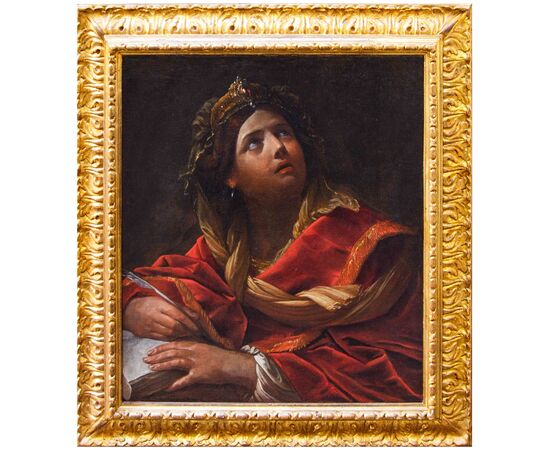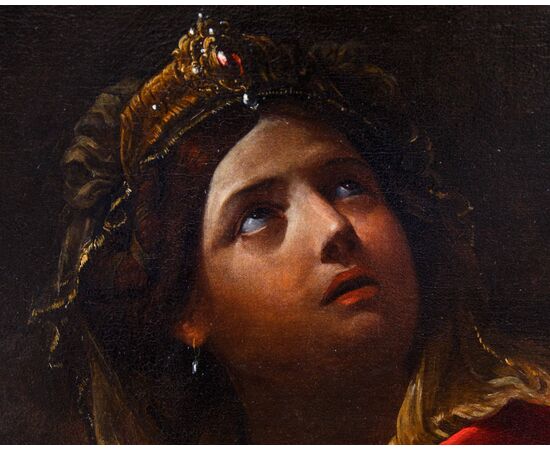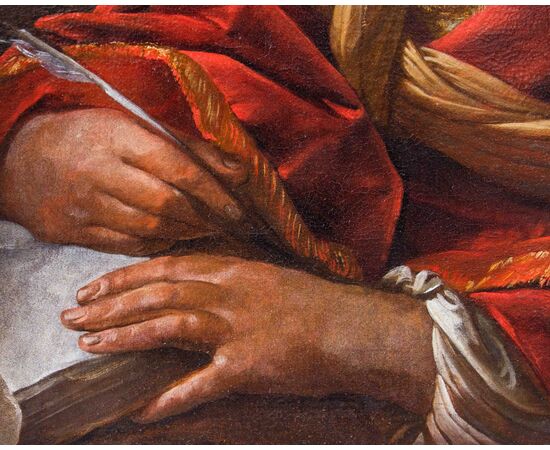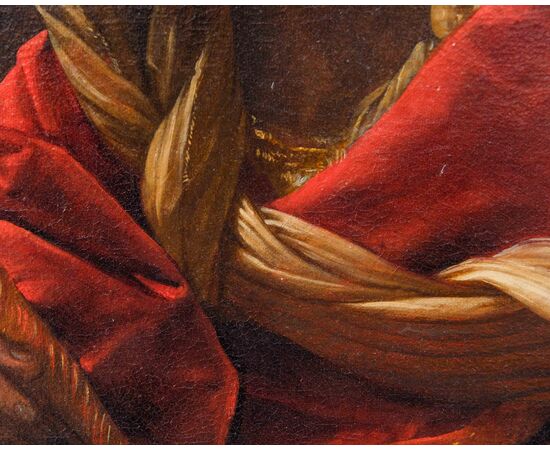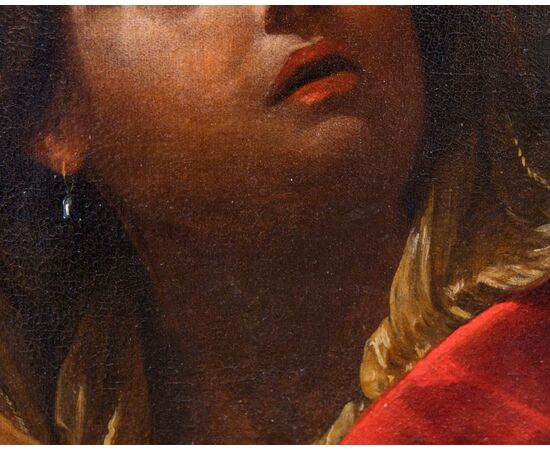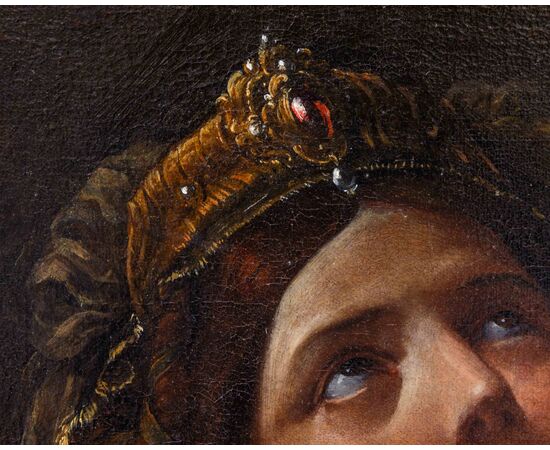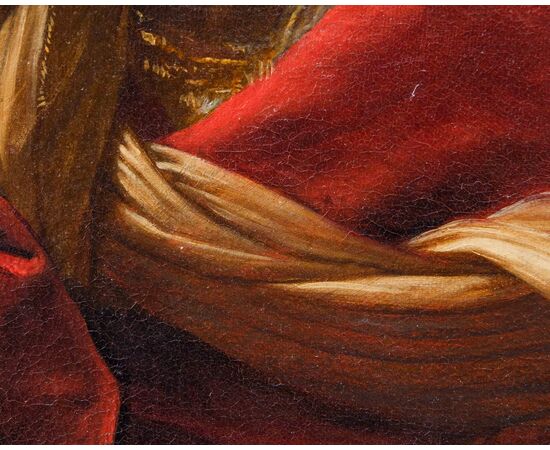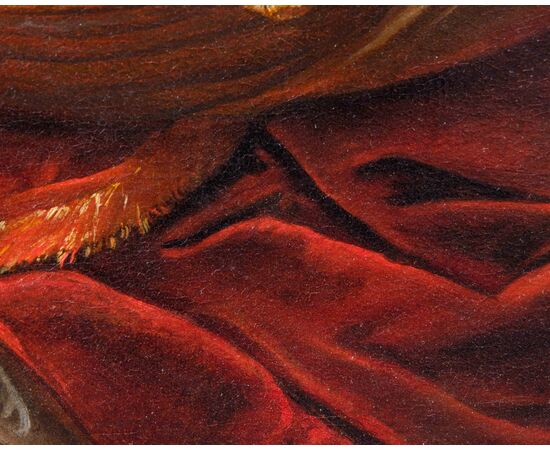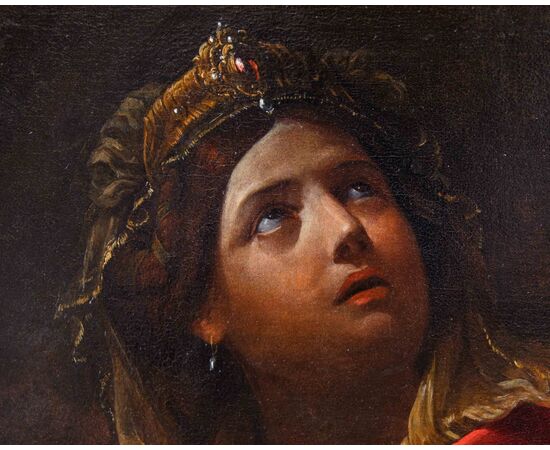Giovanni Giacomo Sementi (Bologna, 1580 – 1636), Sibyl
Giovanni Giacomo Sementi (Bologna, 1580 – 1636)
Sibyl
Oil on canvas, 74 x 64 cm
With frame, 93 x 84.5 cm
Oral communication by Prof. Massimo Pulini
Bibliography: Armanda Pellicciari, Giovan Giacomo Sementi, a pupil of Guido Reni, in Bollettino d'Arte, 1984, pp. 25-40. M. Francucci, Giovanni Giacomo Sementi between Bologna and Rome, in Paragone arte, 787-789, 2015, pp. 21-35. M. Pulini, Fragments of a monograph: part one. The metamorphoses of Gian Giacomo Sementi between independence and service, between Caravaggio and Reni, in About Art on line, June 2019, ad vocem. M. Pulini, Gian Giacomo Sementi. Porzia, in Quaderni del Barocco, Museo di Ariccia 2021, ad vocem.
The canvas in question, of clear Emilian origin, has been attributed by Professor Massimo Pulini to the hand of the Bolognese artist Giovanni Giacomo Sementi (Bologna, 1580 – 1636), based on the comparison with the same subject belonging to the Zanasi collection in Modena, previously referred to the more generic school of Guido Reni. Son of Vincenzo Sementi, his professional training took place mainly in Bologna in the workshops of the Fleming Denys Calvaert and the celebrated Guido Reni, whom he accompanied to Rome during his stay between 1609 and 1612 and with whom he began a prolific artistic collaboration that led to the creation of works for public and ecclesiastical destination: dating back to this period, strongly influenced by the Caravaggesque lesson learned from the master, are the Martyrdom of Saint Ursula, in the Basilica of San Martino and the Martyrdom of Saint Eugenia, at the Pinacoteca Nazionale of Bologna. In 1615-20 he collaborated with Francesco Gessi and Bartolomeo Marescotti under the direction of Reni, who provided the preparatory drawings, for the frescoes of the chapel of the Sacrament in the Cathedral of Ravenna, commissioned by Cardinal Pietro Aldobrandini, participating in the decoration of the dome, pendentives and pillars. The following year Sementi went to Naples with the master and Gessi to work on the chapel of the Treasury in the Cathedral, a project that failed due to the opposition of local artists, as documented by Carlo Cesare Malvasia in his work Felsina pittrice (1678, 1841, pp. 246 s.). From 1624, however, he was documented in the service of Cardinal Maurizio di Savoia, who pushed him to move to Rome in 1626, where he took part in the general congregation of the Academy of San Luca. Remembered as one of the main painters of his time by Giovanni Baglione in his Le vite de' pittori, scultori et architetti, he died in Bologna in 1636.
During his career Sementi fully absorbed the lesson of Guido Reni, whose painting was distinguished by grace, compositional elegance, skillful use of color and, above all, the ability to infuse the figures with an aura of profound spirituality and melancholy, developing however an artistic trait that acquired its own individuality and autonomy: this propensity is evident by looking, for example, at the altarpiece depicting the Madonna and Child enthroned with saints Joseph, Francis and Saint bishop of Poggio Mirteto, in which he reached a refined tenebrous synthesis that, in the stylistic course of the last years of his life, saw him dialogue on par with Lanfranco. At the beginning of the seventeenth century, parallel to a change in taste in a classicist direction, there was also the transformation of the iconography of the Sibyl, which from being elderly, wise and severe, a feminine specular of the figures of old prophets, began instead to be interpreted as a fascinating young woman. Very close conceptually to the Sibyl presented here, in addition to the already mentioned one in the Modena collection that takes up the attribute of the book, is the Suicide of Porzia half-figure from the Durazzo Pallavicini collection in Genoa: in both cases the protagonist is depicted in the classic evocative pose of many saints with eyes turned to the sky suggesting an otherworldly vision or a profound meditation, recalling, through the bulk of the bust and livid complexion, also certain Lombard examples, from Morazzone to Cairo.
In this canvas emerges the artist's ability to evoke a sense of transcendence while maintaining a strong physical presence. The delicacy of the facial features, the softness of the styled hair and the richness of the drapery contribute to create an image of extraordinary refinement, infusing an aura of solemn dignity and a typically Renian pathos, which makes her deeply human and at the same time almost divine.

